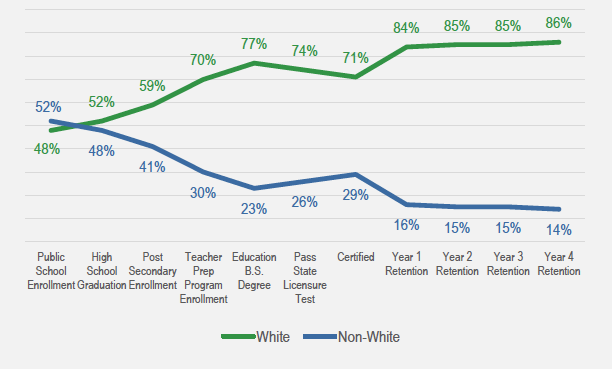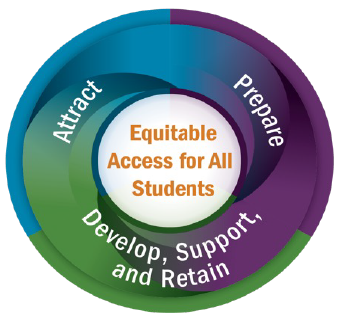Despite funded initiatives to attract, hire, and retain teachers, Illinois continues to struggle with teacher shortages, particularly in hiring diverse teaching staff to reflect communities served by public school districts. In conversations with the Region 9 Comprehensive Center (R9CC) about the challenge, Illinois State Board of Education’s (ISBE’s) Department of Teaching and Learning staff raised the need for additional evidence, resources, and support to better understand teacher shortages and how to strengthen recruitment and retention efforts.
Year 1: Understanding the Data
To develop a more holistic understanding of the teacher shortage challenge, R9CC worked with ISBE to use available data to analyze the loss of potential teachers, from college through the first 5 years of teaching. R9CC staff brought in subject matter experts from the Center on Great Teachers and Leaders (GTL Center), a former federally funded content center now operated by the American Institutes for Research (AIR). GTL Center staff provided the Teacher Shortage Tool, which uses available data to analyze the loss of potential teachers by multiple characteristics. Resulting visualizations, like the Illinois – Race Gaps in Teacher Retention Rates figure (right), were key supports for the next steps in the Illinois Teacher Recruitment, Retention, and Recognition partnership.
R9CC and ISBE staff used the data visualizations in a collaborative data review process to understand and prioritize problems, discuss deeper conceptualizations, and elevate more effective plans and solutions. The collaborative data review led ISBE to identify eight components of the shortage; these were key to guiding ISBE’s next steps in aligning evidence-based strategies with the state’s unique issues in strengthening the teacher workforce.
The Teaching Pipeline
Data visualizations produced through GTL’s Teacher Shortage Tool show where potential candidates diverge from the route to teaching from high school graduation through 5 years of teaching. ISBE staff said the visualizations drove home the fact that the staffing process is a “pipeline.” This realization helped ISBE staff to shift their thinking about strategies:
If it's a pipeline, then you need to attend to the health of the pipeline at various points in various different ways, as opposed to just having a set of retention strategies or a set of recruitment strategies.

Shortage Components in the Illinois Teacher Pipeline
The Center on Great Teacher’s and Leaders’ Talent Development Framework outlines ways that state- and district-level policymakers can systematically improve educator quality and address teacher shortages. In working with the Talent Development Framework, ISBE identified components of the shortage in Illinois.

Equitable Access for All Students
- Illinois experiences disproportionately low enrollment of students of color in college educator preparation programs.
- In 2019, schools in rural Illinois experienced the highest rate of unfilled teaching positions compared with urban and suburban schools.
- Illinois experienced 1,858 unfilled teaching positions in 2019, with special education, STEM, elementary education, and bilingual education accounting for 72% of them.
- Illinois experiences a lack of local educator preparation program options for students in the northwestern and southeastern regions.
- A disproportionate number of newly certified individuals of color are not becoming first-year public school teachers in Illinois.
- Illinois experiences decreasing retention rates for teachers in their first 4 years (first year: 86.6%; second year: 76.8%; third year: 68.4%; fourth year: 61.1%).
- Illinois experiences low school-level teacher retention rates in low-income schools (50%) and low-performing schools (42%).
- Illinois experienced higher attrition rates for teachers of color that White teachers throughout their first 4 years of teaching, with Black teachers leaving the state educator workforce at the highest rate: Black (57%), Latinx (43%), and White (39%).
Year 2: Aligning Evidence and Stakeholder Perspectives
R9CC coordinated and conducted qualitative data collection and stakeholder meetings to help ISBE learn more about why potential educators are not in classrooms. Although the COVID-19 pandemic made data collection more difficult, R9CC staff ensured that a diverse range of Illinois educators shared information on their decisions to become or remain professional educators.
At the same time, R9CC prepared a series of research briefs that align evidence-based strategies with the shortage components:
- Recruiting and Retaining Bilingual Teachers
- Recruiting and Retaining New Teachers
- Recruiting and Retaining Rural Teachers
- Recruiting and Retaining Teachers in Low-Income and Low-Performing Schools
- Recruiting and Retaining STEM Teachers
- Recruiting and Retaining Teachers of Color
- Recruiting and Retaining SPED Teachers
ISBE and R9CC used the stakeholder feedback and aligned evidence-based strategies to guide planning for next steps in addressing pipeline issues.
The strategy scans are a primary resource that we would not have had [without R9CC].
Year 3: Planning With Stakeholder Voices
 R9CC coordinated a strategy session with statewide stakeholder groups. The session was designed to “pressure test” the identified shortage components and the aligned evidence-based practices against the programs for addressing pipeline issues currently available to stakeholders. The 23 stakeholders represented rural schools, institutions of higher education, and Grow Your Own organizations, among others. The discussion uncovered gaps, overlaps, and misalignments in existing programs and practices, setting the stage for ISBE’s development of evidence-based, stakeholder-informed policy decisions.
R9CC coordinated a strategy session with statewide stakeholder groups. The session was designed to “pressure test” the identified shortage components and the aligned evidence-based practices against the programs for addressing pipeline issues currently available to stakeholders. The 23 stakeholders represented rural schools, institutions of higher education, and Grow Your Own organizations, among others. The discussion uncovered gaps, overlaps, and misalignments in existing programs and practices, setting the stage for ISBE’s development of evidence-based, stakeholder-informed policy decisions.
ISBE compared the strategies included in the research briefs with current initiatives and stakeholders’ perspectives on solutions to pipeline problems in conversations with R9CC as a thought partner. Through this process, R9CC and ISBE built on understandings developed through data collection, stakeholder feedback, and alignment between existing initiatives and evidence-based practices to support ISBE’s planning process to identify initiatives to effectively target workforce pipeline issues. One ISBE staff member explained that the “quick wins” made possible by the work, like effectively targeting grant funding to districts to address retention, will directly affect students in those schools.
Looking Forward
In the continuing partnership, R9CC will support ISBE’s goal of using an effective continuous improvement process for addressing teacher pipeline shortages. In the long term, ISBE’s ability to select evidence-based strategies to address teacher pipeline issues specific to Illinois will ultimately address equity and diversity gaps in the teacher workforce.
This project will inform policy decisions over the next 5 years that make a difference because we’re doing the work correctly and using information to make program policy decisions that are responsive to the data.
ISBE 2020 STRATEGIC PLAN: GOAL 3
Illinois’ diverse student population will have educators who are prepared through multiple pathways and are supported and celebrated for their efforts to provide each and every child an education that meets their needs.